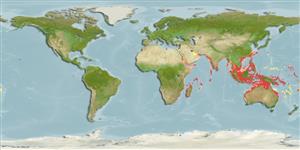Environment: milieu / climate zone / depth range / distribution range
Écologie
marin récifal; profondeur 0 - 90 m (Ref. 9710). Tropical; 28°N - 35°S, 26°E - 149°W (Ref. 57373)
Indo-West Pacific: East Africa, India, and Malaysia to the Moluccas, north to Taiwan, south to northern Australia. Single record from Fiji. Appears to be absent from oceanic islands of the Indian Ocean.
Taille / Poids / Âge
Maturity: Lm ? range ? - ? cm
Max length : 20.0 cm TL mâle / non sexé; (Ref. 4113)
Description synthétique
Clés d'identification | Morphologie | Morphométrie
Épines dorsales (Total) : 3; Rayons mous dorsaux (Total) : 13; Épines anales: 0; Rayons mous anaux: 7. First dorsal spine about the same length as the 2nd dorsal spine, with a large tuff of filaments. Ground color of head and body light-tan with narrow blackish brown streaks. All fins with blackish-brown spots. Illicium longer than next dorsal fin ray with small rounded to elongate esca (Ref. 48635). Attains 45 cm SL.
Inhabits still muddy habitats that are either deep or offshore (Ref. 48635) or shallow rocky and coral reefs (Ref. 9710). Oviparous. Eggs are bound in ribbon-like sheath or mass of gelatinous mucus called 'egg raft' or 'veil' (Ref. 6773). Minimum depth reported taken from Ref. 57178. Solitary and often among leaf-eater debris (Ref 90102).
Life cycle and mating behavior
Maturité | Reproduction | Frai | Œufs | Fécondité | Larves
Oviparous. Eggs are bound in ribbon-like sheath or mass of gelatinous mucus called 'egg raft' or 'veil' (Ref. 6773).
Pietsch, T.W. and D.B. Grobecker, 1987. Frogfishes of the world. Systematics, zoogeography, and behavioral ecology. Stanford University Press, Stanford, California. 420 p. (Ref. 6773)
Statut dans la liste rouge de l'IUCN (Ref. 130435: Version 2024-2)
Menace pour l'homme
Harmless
Utilisations par l'homme
Outils
Articles particuliers
Télécharger en XML
Sources Internet
Estimates based on models
Preferred temperature (Ref.
123201): 24.6 - 29.1, mean 28.1 °C (based on 1846 cells).
Phylogenetic diversity index (Ref.
82804): PD
50 = 0.5005 [Uniqueness, from 0.5 = low to 2.0 = high].
Bayesian length-weight: a=0.02630 (0.01029 - 0.06725), b=2.96 (2.73 - 3.19), in cm total length, based on LWR estimates for this (Sub)family-body shape (Ref.
93245).
Niveau trophique (Ref.
69278): 4.2 ±0.73 se; based on food items.
Résilience (Ref.
120179): Haut, temps minimum de doublement de population inférieur à 15 mois (Fec assumed to be > 10,000).
Fishing Vulnerability (Ref.
59153): Low vulnerability (10 of 100).
Nutrients (Ref.
124155): Calcium = 52.2 [25.3, 93.0] mg/100g; Iron = 0.623 [0.324, 1.126] mg/100g; Protein = 18.7 [16.2, 22.0] %; Omega3 = 0.122 [0.046, 0.307] g/100g; Selenium = 28.1 [12.5, 69.5] μg/100g; VitaminA = 180 [44, 716] μg/100g; Zinc = 1.03 [0.64, 1.60] mg/100g (wet weight);
